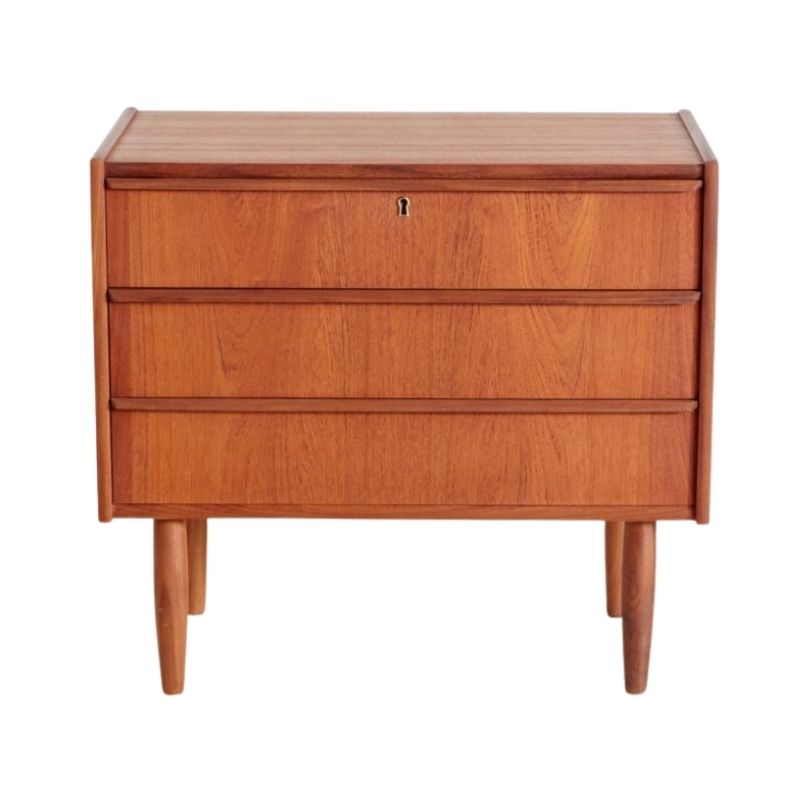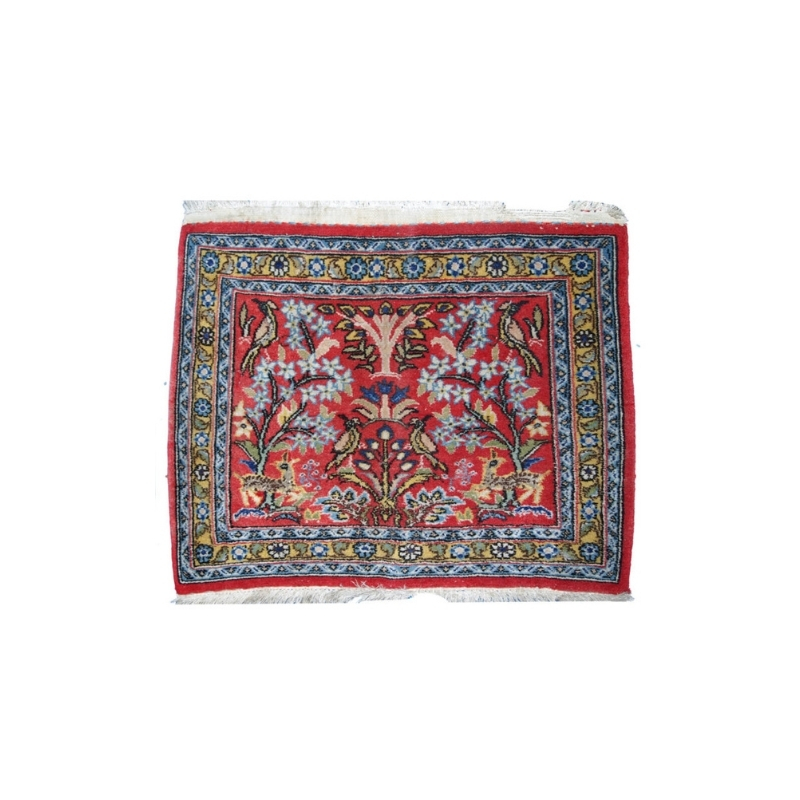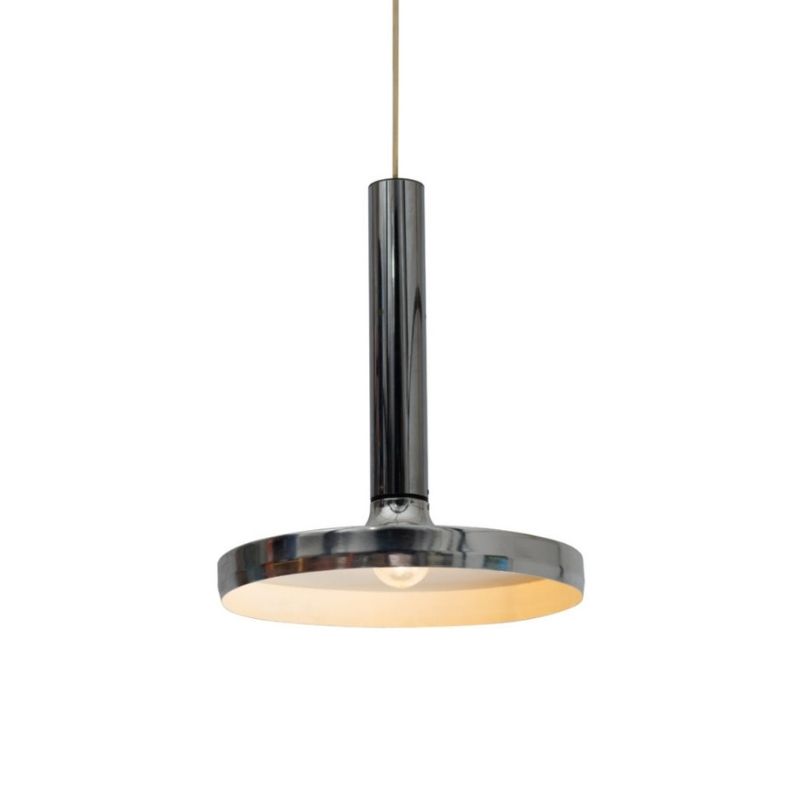Coincidentally, I just...
Coincidentally, I just picked up a set of four of these Ostergaard chairs myself last week. First time that I've found a set of Danish chairs that actually has real leather seats rather than the usual leather-like vinyl.
Unfortunately, one of the backrest supports had an old break in the wood, and had only a single screw loosely holding it together. There was not too much wood missing, so it glued back together fairly tightly. After some teak sanded sawdust with wood glue filler and a little red chestnut stain, it now looks somewhat presentable, although clearly a repair.
Although I had come across this design every now and then online, I didn't realize how scarce it was compared to the other Ostergaard/Randers chair with the "Hvidt lip" back (at least here in the US). No current or three-month sold examples on eBay, and only two high-priced sets and a single on 1stDibs.
The backrest design is quite elegant up close in person. (First two photos from my iPhone more meant for seat info; the third one is my favorite image found online for the backrest).
I strongly suspect the
leather is a reupholster job. It isn't trimmed neatly the way most (all?) original Danish seats are done. The combo of staples and tacks is a clue, too, and they would all be in a neat, straight line if original.
The top of the seat looks great, though! The corners are done really well. I hate when they have unsightly tucks and folds.
Yeah, I agree not original....
Yeah, I agree not original. Didn't clarify that in the previous post. I believe the white fabric visible on the right side is a separately stapled underlayer and not the original upholstery, as it looks to be a loose weave and low thread count on close inspection. Is that standard for leather seats to separate it from the foam or to contour the foam before applying the leather?
Nope, not standard.
Upholsterers often will add a layer of padding to make up for the loss of resiliency of the original padding (when they do not strip the chair completely--I think usually to save time?).
But woven and low thread count---not sure what this fabric might be or what purpose it served. I've seen a lot of thin polyester batting added later on top of old foam or foam and fabric.
If the existing leather is in good shape on the visible parts of the seat, I'd be really tempted to run a line of staples around the perimeter on the underside about one inch in, then trim close to the staples with a razor blade. Then remove the excess leather and the staples and tacks. (Pneumatic staples if possible. Electric staple guns rarely have the juice to fire staples all the way in.)
Congrats on your find. I...
Congrats on your find. I agree, the flow of the legs into the back piece is a beautiful design. I'm going to attach a photo of the bottom of one of my chairs. I can't say for sure, but my assumption is that the upholstery on these chairs is original. The staples are quite orderly and linear, and the spare material is minimal.
Spanky, hi. Concerning the b...
Spanky, hi. Concerning the band you cited, is it unreasonable to hope my local upholsterer can duplicate the tidy appearance of the chair bottom and the way it is finished? I'm supposed to take the chair bottoms in to the upholstery shop on Mondday 6/2.
Don't be afraid of the wood...
Strip it. Strip all of it. Be gentle and examine anything you can take apart and feel comfortable putting back together. More pieces makes it easier. You'll be glad you did down the road. Don't get hung up on whether or not refinishing will damage the value... focus on making it the thing you want it to be. If it becomes that, other people will want it, too, if that's your angle. If you don't ever plan on selling it, all the better.
I don't know what this table is made of, but it shouldn't matter. Get some chemical stripper instead of sanding the finish down. Citrustrip will do the job but it's finicky and kinda a mess. It will be a lot easier if you can disassemble it. Just keep telling yourself that it's damaged and that it needs to be repaired.
If you choose Citrustrip, cover the whole table as fast as you can. Just throw on enough with a brush to get it covered. Since there is no paint, it's going to absorb the finish fast, and dry out. Stand around the table for up to half an hour, brushing more on spots that dry out. The only problem you can run into is if you pour some on a spot and leave it sit... it will result in a slightly lighter color around where it sat. Best to pour it into something and brush it on lightly, covering the whole piece fast at first and then brushing on more as it starts to dry. The finish on this table isn't paint, so understand that you should only use as much as you need to get the whole thing covered. It won't do significant damage if you apply it too heavy, but it's less cleanup and works faster if you keep applying light amounts where the stripper dries too fast. Do this for maybe half an hour. Once you get the whole thing covered and wet, it could take a while, depending on your temp and humidity. If you're super anal, just hang out with it and watch what happens. You'll be able to tell when it dries because it turns white. You can just put more on at this point and the fresh stuff will wet the old. You're going to scrape it all off, anyway, so don't worry. Get a nice, quality scraper, something like this: http://www.alibaba.com/product-detail/carbon-steel-PP-handle-wide-blade_...
cont'd
You don't want a sharp edge... just straight and thin. After the stripper sits and congeals for a bit, take it off with the scraper and put it in a bit or a trash can, whatever you want. It isn't super toxic but it's easier if you have something to discard it into. If you wait too long, it will be dry and brittle and won't come off as well. If you don't wait long enough, it will be soupy and sloppy. The ideal time is when there is just enough wet stuff on the top of the stripper that it won't drip everywhere, but is still fairly wet. The finish is going to dissolve fairly easily if you applied it right and kept it wet, so it's better to take it off at this point than waiting for it all to dry up and having to do it again. Scrape it off with the scraper... it isn't math and you'll get a feel for what's going on as you go. My guess is that the lighter spots are water and other types of damage to the finish, which I would assume is lacquer. This is going to soak up the stripper quickly and should come off clean if you apply it correctly.
If not, or if you'd rather go the more anal route... use a liquid stripper that you rub on that contains methylene chloride. This is a safer play but it contains harsh chemicals and takes forever. You soak a pad or steel wool in it and then rub it gently on the surface, dissolving the finish. Methylene chloride is the heavy stuff professionals use. It works fantastic, but it's a harsh chemical and you're gonna burn through steel wool or whatever pad stripper you use if you do this from the get. This stuff is best to clean up whatever is left behind after using Citrustrip, as you can rub it on with a rag (wearing gloves, of course) and most of what remains will disappear.
If this table is veneer... again, don't be afraid. As long as you're not soaking the wood with water or other types of stuff and working in a garage or place where there is plenty of ventilation and reasonable temperatures... you can't go wrong. You will hit the learning curve for the stuff and come out thinking you can refinish anything. A flat surface like that will be no problem to strip. If you don't choose Citrustrip, the same rules will apply for using thin coats quickly to build a surface and then wetting drying spots until you've got the whole thing congealed at once.
Use Mineral Spirits to clean up everything. You can use Murphy's Oil Soap, but I would do so sparingly and only in the event that there is an actual stain that has been mottled... come back for more advice in that case. Mineral Spirits on a rag that are gently wiped and the cleaned up with a clean rag will be the safest and will allow you to see what the wood will look like when you apply the new protective coat. Just don't pour it on the wood and you'll be fine.
cont'd
You can sand this without fear, and may need to depending on how the color looks once the finish is off. Just start at 100 or 120 and go lightly, stopping when you've got your desired color or even look. Save some for the higher grits if you feel like you're getting close. You'll read a lot of people saying that you should never sand veneer, if this table is veneer... that's stupid. Just don't put heavy grit on a belt sander and stab it with it and you should be OK. If you're worried about ruining anything, you'll probably be careful enough. I use a finishing sander on large flat surface, veneer sides and such, and it's easy to get them clean without going through the veneer. I'm guessing that after you strip and wash with spirits and let dry for a day that the wood will most likely look perfect with only minimal sanding in spots. Just a hunch.
I have no advice for fixing chairs that have been made shorter... take that to a professional right away and consider what he says. Find the oldest guy with the dirtiest shop you can. For the table itself, try my advice and I'm sure you'll realize that you didn't have too much to worry about. If you get a good, flat scraper that doesn't have a sharp edge and use it properly, you're gonna get that finish off with no problem. Buy a set of small brushes, like toothbrushes only stiffer, at the hardware store. These are good for rounded edges and seams and things.
Once you get it stripped, come back for more advice. The finishing touch is the most difficult and confusing step. Good luck.
I should add...
The liquid stripper is going to be more friendly on the chairs than the Citrustrip, on account of angles, but it will again, take forever. I would suggest you strip the table first and learn the technique before tackling the chairs. Whatever you do, always clean the surface that you have stripped as soon as you have everything removed. Even if there is still finish on the wood, clean off all the stripper with Mineral Spirits, diluted dish soap, or Murphy's Oil soap. Nothing worse than cleaning dried stripper residue a day later.
Gary S: I really shouldn't...
Gary S: I really shouldn't think it unreasonable to request tidy upholstery job like the original. It is really quite simple to stretch fabric over that seat, so it shouldn't be unreasonable to ask a professional to do it tidily.
Oh, and you table top is absolutely veneer. I can tell just from the grain. And as spanky said from the edge banding.
Thanks mgee76.
Yes, thank you for taking the time to write such good suggestions. I've actually been working on the project the last several weeks. The table top and legs have been stripped (actually two times) and sanded. For the burn ring, I sanded until the O became a C, the used 4 ought steel wool and acetate to kind of scrub the remaining ring from the grain.
Generally it looks pretty good, but still a few faint scratch lines and dents / gouges remain. I've taken three stabs at the gouges, first steaming, then using a filler (way too light - removed with acetate and Q-tips). For the third attempt, I sourced a couple of color sticks from a local art supply and ground them with a mortar and pestle, then mixed into the putty base. Looked promising when wet, but was too light after drying and sanding. I'm gonna make another run at it to see if I can dial in the color match.
That's the current update on the table.
Gary
If you need any help, please contact us at – info@designaddict.com









